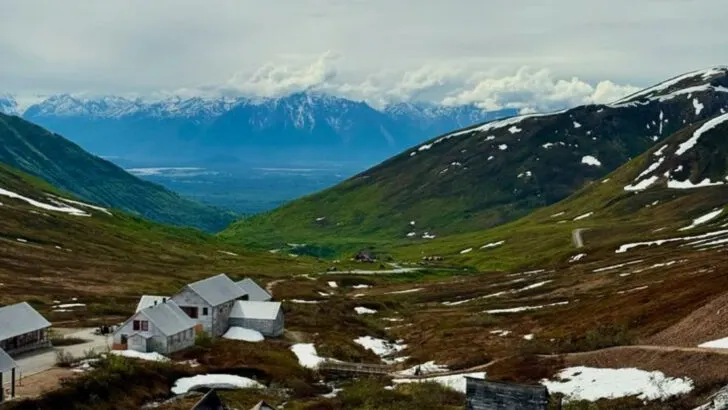Alaska isn’t just glaciers and moose — it’s way deeper than that. While most tourists are busy snapping selfies with snow-capped mountains, they’re missing the real heart of the place. The stories. The traditions. The moments that don’t come with a souvenir shop. From native dance gatherings to centuries-old fishing rituals, Alaska has a pulse that doesn’t make it into most guidebooks. But if you know where to look, it’s unforgettable. These 11 cultural experiences are raw, rich, and wildly human — and they’ll change the way you see the Last Frontier forever.
Tundra Cotton in Rural Village Walks
Tundra cotton, with its wispy, soft tufts, quietly adorns the landscapes around many Alaskan villages. This plant is easily overlooked, yet it holds significance in traditional life, marking the short and vibrant growing season in these regions. Walking through a rural village, one might glimpse locals using tundra cotton in various traditional practices, symbolizing a connection to the land. This simple plant serves as a poignant reminder of the fleeting summer and the unique adaptations of Alaskan communities to their environment.
Spruce Trees and the Art of Spruce Root Weaving
In the hands of skilled Tlingit and Haida artisans, the roots of Sitka spruce transform into intricate baskets and hats. This art, rich with tradition, requires more than just a museum visit to truly appreciate. Witnessing the craft in its natural setting, surrounded by towering spruce trees, offers a profound connection to Alaska’s cultural heritage. The resilience and creativity of these artisans highlight a deep respect for nature and an enduring cultural legacy, woven together through the delicate strands of spruce root.
Fireweed and Its Role in Seasonal Markers
Fireweed, with its dazzling pink blooms, does more than decorate Alaskan landscapes. It serves as a natural calendar, helping locals track the phases of summer. As the flowers bloom sequentially from bottom to top, they provide cues for activities like berry picking and signal the approach of autumn. This vibrant wildflower embodies the rhythm of life in Alaska, offering both beauty and practical guidance to those who understand its silent language. Observing fireweed in bloom is like reading a living chronicle of the Alaskan summer.
Birch Trees and Birch Syrup Farms
Amidst Alaska’s forested expanses, birch trees offer more than shade and beauty. Few realize that these trees are tapped for birch syrup, a sweet delicacy rooted in Indigenous traditions. Visiting a birch syrup farm reveals the meticulous process of sap collection and transformation. This practice, bridging ancient knowledge and modern agriculture, highlights a sustainable approach to utilizing natural resources. A tour of these farms offers insight into a lesser-known aspect of Alaskan life, where each drop of syrup tells a story of heritage and innovation.
Wild Berries and Subsistence Gathering Culture
Blueberries, salmonberries, and other wild fruits are integral to the subsistence lifestyles in many Alaskan communities. Each summer, families venture into the wilderness to gather these berries, honoring traditions passed down through generations. These practices are more than just a means of sustenance; they are cultural rituals, often shared through storytelling and community gatherings. By participating in or witnessing these berry-picking expeditions, one gains a deeper appreciation for the resilience and resourcefulness of Alaskan cultures, intertwined with the land’s bounty.
Traditional Fish Camp Experiences
Traditional Fish Camp Experiences offer a glimpse into the subsistence lifestyle that many Alaskans continue to cherish. These camps are not just about fishing; they are about living in harmony with nature and sustaining family traditions.
Participants engage in hands-on activities, learning age-old fishing techniques and preservation methods. The sense of community and connection to the land is palpable, as stories of past generations echo through the campfire.
A historical note: Fish camps have been central to Alaskan Native life for centuries, serving as vital hubs for food, trade, and social gatherings.
Devil’s Club: Prickly, Medicinal, and Respected
Among the dense, green expanses of Alaskan coastal forests, the Devil’s Club stands out with its striking, spiny appearance. This plant, revered for its medicinal properties, plays a significant role in Indigenous healing practices. It’s used in salves, teas, and other remedies, embodying the deep connection between people and nature. While its prickly nature might deter the casual hiker, those who understand its value see a symbol of resilience and traditional wisdom. Devil’s Club is a testament to the healing power of the natural world.
Willow and Alder in Traditional Smokehouses
In the world of Alaskan food traditions, willow and alder wood play a crucial role. These woods are preferred for smoking salmon and other delicacies, imparting a distinct flavor and aroma. Traditional smokehouses, often family-run, use these resources to preserve and prepare food, reflecting a way of life deeply connected to the environment. The scent of alder smoke is emblematic of these culinary practices, offering a sensory journey into Alaska’s rich food heritage. It’s a tradition that speaks of resourcefulness and cultural continuity.
Mosses and Lichens in Interior Drylands
In Alaska’s interior and arctic regions, mosses and lichens form a vital part of the landscape. These plants, often overlooked, are crucial for the ecosystem, supporting wildlife and maintaining soil health. For those living off the land, they are familiar companions, offering insights into the environmental conditions. Exploring these drylands reveals the understated beauty and importance of mosses and lichens in sustaining life. They are silent witnesses to the harsh yet vibrant existence that characterizes much of Alaska, often missed by those focusing on grander sights.
Stinging Nettle in Homestead Gardens and Teas
Stinging nettle, with its notorious sting, is a surprising staple in some Alaskan homesteads. Despite its reputation, this plant is valued for its high nutritional and medicinal properties. It’s harvested to make teas, soups, and salves, showcasing the ingenuity of local gardeners. Sharing nettle-based recipes and remedies at farmers markets or through community exchanges highlights a culture of resourcefulness. This plant embodies the spirit of adaptation and survival, turning a perceived nuisance into a treasured resource for health and nourishment.
Subsistence Gardens: Raised Beds in Harsh Climates
In the harsh climates of rural Alaska, subsistence gardens flourish against the odds. Families grow hardy crops like potatoes, kale, and cabbage in small, raised beds, a testament to their resilience and ingenuity. These gardens provide fresh produce, crucial for sustenance, and represent a deep connection to the land. Despite limited soil and short growing seasons, these cultivated spaces thrive, embodying the spirit of determination. Visiting these gardens offers a glimpse into the everyday lives of Alaskans, where each plant is a symbol of hope and perseverance.

